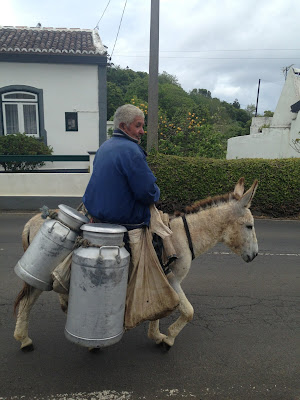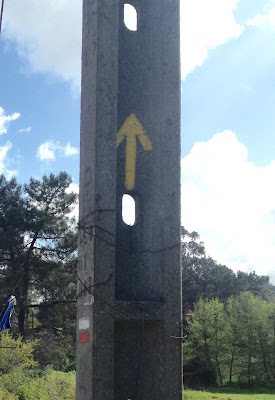After the Camino, I must admit to feeling a bit lost. For almost three weeks I had a mission every day - WALK. And now I was back on vacation. I do much better with a mission (I've always known that) and, having almost three weeks before boarding a flight to the Azores island of Terceira, I had to find a way to fill my days. I started reading up on Portugal and settled on a plan of visiting small historic towns before spending one night in Lisbon where I'd catch a plane. I left Finisterre, Spain on a bus and ended up in Braga, Portugal where, when I checked into my "room" for a two night stay, discovered it was a spacious and stylishly furnished two bedroom apartment. It rained the entire bus ride to Braga, but stopped long enough for me to walk to the apartment, check in and make a run to the grocery store. I had the big bedroom with the spa bathroom accessible only through my room. Two French woman had secured the other bedroom with two twin beds and a bathroom in the hallway for one night. They were friendly and quiet and mostly not there. A perfect arrangement. It rained most of my visit and I used the time not to see the sights, but to lock in and write. Isabel, the owner of the apartment, lived with her college aged daughter across the hall. She taught in a preschool during the day and studied Chinese medicine in the evenings. She also sang in a traditional Portuguese folk music and dance troupe that performs around the country and my second night she invited me to join her for a rehearsal. It was spectacular with music played on traditional instruments accompanied by lively, intricate dances. For three hours, I tapped my feet and smiled so broadly my cheeks hurt! I was given a lesson on how to use the castanets (much more difficult than it looks) and a CD of their music. I left Braga the next morning by bus for Porto where I'd left a small box of possessions before my Camino. This trip to Porto was so different from my first visit when I had been there recuperating from shin splints. Pain free, I visited the farmers market, walked the bridge across the Rio Douro and wandered the streets of the old section of town. I tried to claim a spot on a tour of the Sandeman Port Winery, but they were booked solid. Although Porto is the second largest city in Portugal after Lisbon, it has the feel of a much smaller town with lots of cobblestone streets, small cafes and quaint hotels. Its historical core is a UNESCO World Heritage Site. A lovely and affordable place to visit.
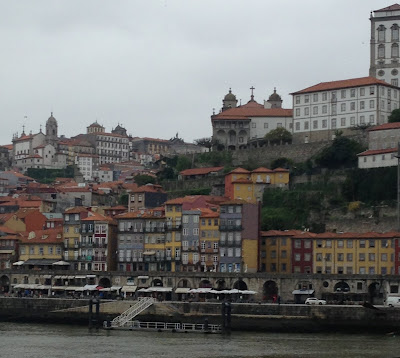
On the banks of the Rio Douro in Porto
Next stop, Tomar. Considered one of Portugal's historical jewels, it was founded by the Knights Templar and the Convento de Cristo monastery and the Castle sit on a hill overlooking the town. The grounds surrounding the castle are a maze of paths through tall trees and beautiful plantings. At breakfast the first morning, I joined a few folks who were walking the Camino (Tomar is on the Camino route from Lisbon) and also Red, a man on vacation from Oregon. As we traded stories, I mentioned I was considering catching a bus to Fatima, a religious shrine about 40 minutes west of Tomar. Red told me he also was wanting to visit Fatima and he had a car so a plan was made to meet after breakfast. A pleasant ride brought us to a very built up Sanctuary with a massive blacktop plaza capable of holding over 60,000 people. We observed some people doing penance by traversing the plaza on their knees. At the entrance to the sanctuary is a 5,732 pound chunk of the Berlin wall behind glass. There were quite a few people there in preparation for the huge celebration on May 13th, when the plaza would be filled to capacity (I watched the proceedings on TV in the train station cafe on my way out of Tomar). On the 13th of every month from May to October in 1917, it is said that the Virgin Mary appeared to three shepherd children on this site. So those days draw heavy crowds of the devoted. We walked back through town, past tourist shops full of religious icons, ate lunch in a small cafe and headed out to Santarém, a town on the Tagus River. We wandered through town for hours, walked the gardens on the grounds of an ancient Moorish citadel and got caught in a wicked thunderstorm. The architecture is an amazing mix of Roman, Gothic, Renaissance and Baroque! Back at the hotel hours later, it was obvious the storms had hit Tomar also as the Nabão River, which cuts through the town was swollen, muddy and running fast. The next morning I walked the Castle hiking trails and while on a very overgrown, mostly unused trail that intersected with a paved trail I came across a young couple with backpacks who I assumed were Camino walkers. I said, "Bom dia!" (Good day in Portuguese) and they nodded their heads at me. I next asked, "Are y'all doin' the Camino?" (Don't know why I turned Texan all of a sudden). They looked at me oddly and replied in broken English, "We don't speak Portuguese!" That afternoon Red and I paid a visit to the Matchbox Museum. I was thinking Matchbox cars and was less than enthusiastic, but no, this was the world's largest collection of actual boxes of matches. Six rooms full. Really. Some dating from the late 1800's and categorized by country. It was more interesting than it sounds. Not the highlight of my Tomar visit, but it held a strange sort of fascination. The next day I was back at the train station to catch a train to Evora, a town I'd been wanting to visit for months. The train took me to Lisbon where I'd catch another train to Evora. I had a two hour wait, so I went to a cafe I'd been to more than a month earlier when I was in town to start my first attempt at the Camino. My phone connected to their Wi-Fi immediately, having stored the passwords weeks before. I really appreciate this feature! I caught up on mail and news while I nursed a coffee and then walked to the platform to catch my train. My ticket listed the car number and seat number so I walked to car 22 and tried the door, but it was locked. It was fifteen minutes till the train left, so I sat on a bench on the platform to wait. Soon the platform filled with people but the doors remained locked, which seemed odd. At 5:02, which was the time the train was scheduled to leave, the front three cars of the train headed down the track. I walked up to a couple sitting on a bench and pointed to the train locked up tight in front of us. "Evora?" I asked. They pointed to the train disappearing down the tracks. Damn. I walked to the ticket booth and they gave me a ticket for the next train, two hours later. I felt only marginally less an idiot when I noticed a few other people who'd been on the platform with me, getting new tickets too. I caught the next train without incident and pulled into Evora around 8:15. It was still light, but not for long. I followed an elderly lady out of the train station and watched as her husband walked up, grabbed her bag and gave her a big kiss. I took the opportunity to stop them and ask the direction to the old part of town. "You walk?" She asked me. "Yes." I replied, "No problem!" But they wouldn't hear of it and grabbed my bag, opened the back door of their car and motioned me in. They drove me into town and then walked me to the door of my hotel - about 2 blocks! This is the sort of kindness I experienced throughout Portugal. Amazing people! The man at the front desk showed me to my room and my heart fell. It was a dingy closet with a twin bed and a sink. The bathroom was a half mile down the hall (not really, but it seemed that far when I got up in the middle of the night to use it...). It was late, so I just crawled into bed and went to sleep. The next morning I availed myself of the free breakfast and left to see Evora. A visit to the Chapel of Bones was first on my list. A small chapel attached to the Church of St. Francis, the interior is covered with skulls and bones dug up from the town in the 16th century. The Franciscan monk who built it intended it to create contemplation on the transitory nature of life. Indeed, a motto carved in marble above the door says, "We bones that are here, for yours await." Pleasant. The chapel itself is lovely - clean and hushed. I expected grisly and got reverence.
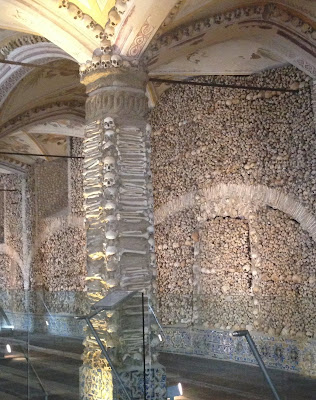


As I walked out of the chapel, it began to sprinkle, so I walked towards my hotel. By the time I reached it, the rain had picked up. I grabbed my key at the front desk and walked to my room which, with dark skies dumping rain outside, seemed even gloomier than the night before. I decided I couldn't do it...I couldn't have this room be my base for the next three days. It was 11:30 and checkout was by noon. I packed my backpack and headed to the front desk, my stomach doing flips with every step. I had never checked out of a hotel because I didn't like it before. I approached the desk clerk, the same one I'd joked with the night before and put my key on the counter. "I'd like to check out. My room just isn't what I expected." He didn't say a word, just sat there and looked at me. "I'm sorry." I added. I hadn't paid my bill yet and the hotel only took cash so, as he changed the booking and printed my bill, I went online and booked a new room I'd scoped out that morning. And just like that, I was out of there. I walked in the rain to the new hotel and sat downstairs waiting for reception on the third floor to open. The new room was just that, new. They had only been open a month or two and it was spacious and clean and furnished with painted furniture typical of the region. Once again a room without a bathroom, but it was directly across the hall and even had a bathtub. What's more, I was the only one staying there! When the proprietor left at seven in the evening, I had the whole place to myself. The next morning I walked to the train station to buy my ticket to Lisbon and realized I could've walked to town my first night as it took me less than 20 minutes. But I got to experience the kindness of strangers. I then walked back to the old part of town, within the ramparts (Evora is a walled city) and walked around the wall observing the difference within - cobblestone streets, traditional building techniques, huge trees - and without - modern hotels, traffic going through roundabouts, billboards. I sat on a bench carved into the ancient rock wall at the edge of a garden. I watched a lady walking towards me and I estimated her to be about my age, a tourist like me and maybe German. Beverly turned out to be English, not German but I hit the mark on all the rest. We sat and talked for two hours and when the rain started, we ducked into one of the tiny stone guard houses that were at every turn on the rampart. We walked to a cafe for soup and sat for 90 minutes more. We agreed to meet for lunch the next day. Bev had been traveling solo for about 10 weeks, mostly in Africa, (Gambia and Senegal) doing charity work and was heading to the Algarve in southern Portugal for a week at the beach, then to attend a wedding. We were leaving Evora the same day, on the same train. The next day as we ate lunch she bemoaned the need to dress up for the wedding festivities. Traveling in Africa, she'd not needed fancy clothes. Like me, she saw dressing up as a chore. Throughout Spain and Portugal, I'd been taken a few times to what are called Chinese Stores. Kind of like a dollar store on steroids. Some are small with just clothes and jewelry, but some are like super Walmarts crammed into 2000 square feet. On a trip to the grocery store that morning, I'd passed three of them. So off we went to find Bev a dress. We had a fun and successful afternoon and made plans to meet on the train the next morning. I arrived at the train station early and had a coffee in the cafe before boarding the train as soon as they opened the doors. I stood in the doorway of the train watching taxis drop off passengers, but never saw Bev and I started to worry. It was almost 9:00 and the train would be pulling out at 9:06. I finally went to my seat and Bev came walking down the aisle. She had been waiting for me inside the train station with the same concerns I'd had for her. We made plans to reconnect in England as she arrives home a few days after I get there. I had one night in Lisbon before I caught my flight to the Azores. I'd booked a room at the same place I'd stayed when I was starting the Camino and it was nice to be back. A comfortable five bedroom, two bathroom flat in a great part of town, the owner a dynamic woman named Maria Theresa. Maria's 19 year old son, Francisco, would be picking me up in front of the apartment at 5:00 the next morning to drive me to the airport. There was a futbol match that evening and afterwards celebrations exploded around town. Singing, horns honking, explosions that sounded like cannons...hours of raucous partying. At 2 a.m., after just getting to sleep, a series of messages came in on WhatsApp. Francisco had a fever and had yet to go to sleep. He would be unable to drive me to the airport, but had arranged for a taxi to be waiting downstairs at 5. I messaged him back, thanking him for arranging it and wishing him a speedy recovery. I do hope he got better, but I've heard futbol fever is pretty easy to sleep off.
I caught my first flight to Ponte Delgado on the island of São Miguel, the largest and most populated of the nine islands in the Azores. After a 20 minute wait, I boarded a prop plane to Terceira, my final destination and my home for a week. A taxi took me to the Sawmill hotel in the parish of Aqualva, about a 15 minutes ride. The island of Terceira is the third largest of the nine islands and the land that time forgot. Less than 20 miles long and 12 miles wide, it is mainly an agricultural, livestock and dairy economy. Oh, and did I mention Paradise? This time of year the island is in bloom with hydrangeas, giant purple alliums, geraniums and wild nasturtiums growing everywhere. I checked into the Sawmill complex which rents individual bedrooms in one building with a shared bathroom and a large living room and kitchen or individual apartments in a low slung building across the driveway. I rented the smallest apartment with a small kitchen, a bathroom and a large bedroom. But I spent lots of time in the big kitchen across the driveway. It became a meeting place and lots of plans were hatched there along with some pretty good meals cooked in the well equipped kitchen. Sergio, the owner, is from Lisbon and met his wife in college. She grew up on the island and they now have a sweet 6 year old son. The day I arrived I walked into town, a 10 minute walk, and visited the one small grocery store to pick up supplies for a few days. There are no restaurants in Aqualva and with the big kitchen, I had no need for one. I then took off on a walk through a neighboring parish to find the ocean. The roads were narrow and many without sidewalks, so when I saw a side road heading toward the ocean, I took it. Just a few hundred feet in, the pavement ended and I was walking a dirt road between waist high volcanic basalt rock walls. The island is crisscrossed with these stacked rock walls, used to delineate tilled plots for crops or paddocks for animals. Fencing is almost non existent.

Rock walls as far as the eye can see
Some of the paddocks had cows, but most were simply plots of lush grass. I could see the Atlantic Ocean in the distance, but I never reached it, my forward progress ultimately blocked by, you guessed it - rock walls. I headed back to my apartment and made myself a light dinner. I met a few women staying there, Hannah, a German woman who was heading back to Düsseldorf the next day and Mia, a young college student from Helsinki. They had gone whale watching that day on the south side of the island and recommended the experience. Sergio could make the arrangements. The next morning Sergio delivered Hannah to the airport and returned with a new guest, Nancy who hailed from St. Augustine, Florida but arrived in Terceira from England. Her husband was in a boat race from England to Terceira and she would be at Sawmill until he arrived in 3-4 weeks. We became fast friends and, on her first full day at Sawmill, we decided to take one of the many hikes on the island. Her map said "4 km. Easy hike." A 2.5 mile hike? No problem! We headed out mid morning and figured we'd pick up bottles of water in town. Since the hike was so short, we decided to walk a big loop around the outskirts of the village of Aqualva to reach the trailhead. As soon as we left the village proper, the road headed uphill with, once again, stacked rock walls on either side of the road extending up and over the mountain. It was a couple miles of pleasant walking to reach the trailhead and we completely forgot to pick up drinking water.

When we reached the start of the trail we could see the ocean ahead of us down a long dirt road. I was determined to put my feet in the water at some point that day! We walked and talked and soon the trail started heading down into the woods. I had pictured the trail remaining a nicely tended trail, but we started clamoring down and over boulders and steep narrows that we had to walk down with our feet sideways to keep from sliding. It was actually kind of thrilling to be physically challenged again since I hadn't done any strenuous hiking since the Camino. The land flattened and we came upon a tiny rock house in the middle of nowhere surrounded by small plots of plants I later discovered to be taro. And just beyond, the rocky shore of the ocean.
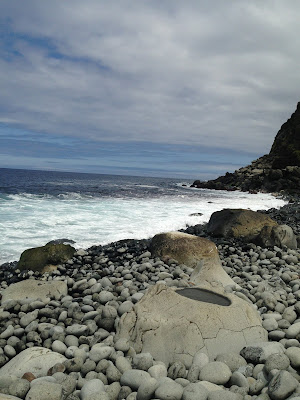
I climbed over the rocks and stood at the waters edge. A wave soaked my shoes, socks and the bottom of my jeans. The water was surprisingly tepid, I'd expected it to be cold. I walked back to Nancy and we headed back out to find where the trail would lead us next. It took us a few minutes to realize we would be walking over the cliff we'd walked beside to reach the ocean. Crude steps had been dug out of the mountainside and we followed them up and over the mountain.
The view from the top was magnificent and we stopped frequently to take pictures. Some of the paths were piles of jagged rocks and others were sections of paved roads, but everywhere the views were of the craggy Terceira coastline.
We'd been hiking a few hours by this time and we were feeling the lack of water. Nancy had some almonds with her, but I thought they'd make me thirstier so I ate some wild nasturtiums growing on the side of the trail. We came to a marker by the side of the path that showed we were close to the end. A half mile more and we were sitting by the side of the road sharing a chocolate bar Nancy had found in her pack and waiting for the bus to take us back to Aqualva.
The next morning at 8:00 the van showed up for the 30 minute ride to Angra for whale watching. Nancy hitched a ride with us although she wasn't joining me because, as she put it, "When my husband gets here and we're sailing between the islands, we'll probably see lots of whales!" So she took off to run errands while I boarded a small rubber dinghy with seven other folks and two crew. We motored about four miles out into the Atlantic Ocean and let the motor idle quietly. They have strict rules about whale watching...no closer than fifty meters, no approaching from the front of the whales and no more than thirty minutes in one spot. Almost immediately, we saw a small blow of water in the waves ahead of us followed by a blackish gray mass that kind of rolled over the top of the waves. A whale! A fin whale to be exact, the second biggest animal on the planet.

It was pretty magnificent and it swam a bit closer before it disappeared. A few other smaller fin whales swam around the boat before we moved on to another spot. On shore, a spotter was on one of the highest cliffs on the waterfront and would radio coordinates to our boat. We motored around for over two hours, stopping to watch the whales swim and spout before heading closer to shore to see dolphins. They swam right up to the boat, some jumping out of the water completely and others swimming under the boat.
A dolphin under the water off the side of the boat
They were playful and energetic and it was a nice way to end the excursion. Back on shore, Nancy and I took off for a restaurant she had seen while running errands. Off the tourist route, it was obviously a spot for locals. We were hoping to have a traditional dish called Alcatra - Portuguese pot roast - and this was the place. For 5€ each we had delicious Alcatra with boiled potatoes, bread, a half liter of local red wine and coffee. After lunch we ran a few more errands, walked through the spectacular gardens and did some grocery shopping before catching the bus back to Sawmill. The next day poured most all day and I stayed in reading and writing and catching up on laundry. We were renting a car the next day to tour the whole island, eat seafood and see a Tourada de Ropa. Sergio arranged our rental car and did the research on the best Tourada de Ropa on the island that night. A "sport" that takes place in Terceira only May through October, it is particular to the Azores, most specifically the island of Terceira. After securing our car, we drove to a waterfront seafood restaurant, Beira Mar, in Sao Mateus and made a reservation for lunch. We then drove to the west side of the island (Aqualva parish being in the northeast) and I was amazed by how different the geography was. Extensive plantations of Cryptomeria Japonica covered the hills and roadsides and the huge hydrangea shrubs were just starting to bloom. It was lush and green with tiny villages dotting the landscape. We made our way to Biscoitos, a village on the north coast marked by coves surrounded by black lava. Platforms have been built with sunbathing areas and stairs down into the natural pools of seawater.

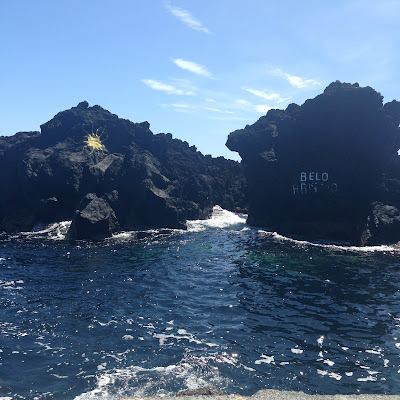

Despite being barely 70 degrees, there were quite a few sunbathers out and even a few people in the water! I could've stayed all day, but lunch called so we headed back to Sao Mateus. When we arrived at Beira Mar, every table was full except one - ours! We started with local bread, cheese and wine; then our entrees of wreckfish and octopus. The wreckfish (so called because the massive fish weighing upwards of 200 lbs frequent deepwater caves and shipwrecks) was a huge slab of broiled fish almost an inch thick. The octopus was the best I've ever eaten (and I tend to eat it frequently here), the huge tentacles being so tender you could cut them with a fork. The meals came with salad and vegetables, which we hadn't seen much. We were stuffed as we headed into Angra to do some grocery shopping. Finally we headed to Praia da Vitória to catch the evenings entertainment of Tourada de Ropa or Bull on a Rope. Two blocks were marked off with chalk and all the ground floor doors and windows partially barricaded with plywood.

The streets were full of participants and onlookers both, the latter (like us) looking for someplace safe to watch the proceedings. We asked a few people the protocol for securing a spot and were told to just keep asking. As we walked past a low balcony with a few people standing there, Nancy asked if we could join them and they told us to come on up. Yes!
Our perch to watch the bull
I had watched a few Tourada de Ropa videos online and had seen the bulls actually leap into the stands. I felt fairly confident this balcony offered safety as well as a good view. A cannon shot marked the beginning and the crowds surged to the spot where the bull was let loose, two blocks away. "Loose" is not really accurate as the bull was secured by a heavy rope held by four to six men (pastores) dressed in white shirts, grey pants and black hats, although a few times I saw them drop the rope allowing the bull to roam freely for a minute. Sometimes, when the bull came after them, the pastores would jump inside a barricade for protection. The crowds behind the barricades would wave their jackets at the bull as he passed and sometimes he would ram the door to try to reach them. Participants on the road would whirl red umbrellas at the bull, encouraging him to charge, then run like hell when he did. Sometimes, from my spot on the balcony, I couldn't see the bull but knew he was coming when the throng began running our way. At one point, with the bull probably twenty feet away, a few teenaged boys parked themselves on the road under our balcony taunting the bull. When he headed our way, the boys climbed the wall to safety.
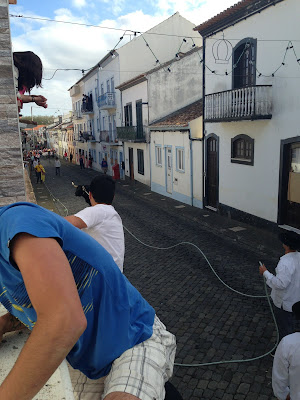

Nancy took this photo and I thought the composition was great!
The bull's horns are capped to diminish the risk if he does make contact with someone. We stayed for two of the four bulls before we headed back to Sawmill. The next day was Sunday and a big celebration was held in town.
We encountered this man on our walk to church.
It started at 10:30 mass at the church in Aqualva, which we attended although we were terribly underdressed. Every man there, young and old alike wore a suit and the women were dressed to the nines complete with heels and hose. We stood in the back as every seat was full and we saw a few folks check us out. When it came time to shake hands, many came to shake ours. It was sweet although we didn't understand a word of the sermon. Afterwards, everyone assembled on the street outside the church as the philharmonic played and a procession of parishioners wearing elaborate crowns paraded by. Men bearing huge baskets of bread began walking through the crowd handing out loaves. When their baskets emptied, they replenished them until everyone had a loaf, Nancy and I included.
We left soon after for the ten minute walk back to Sawmill and everyone we passed was carrying a loaf of bread. Every single one. It was good bread, too!
Black clouds rolled in and when Nancy knocked on my door a few hours later to invite me to join her for the afternoon celebration, I declined. I was writing and packing and rain was threatening. I'm so sorry I didn't go as Nancy reported it was a food feast with the townspeople making their specialties including some traditional Azorian dishes and spirits.
The next morning I flew to Horta on the island of Faial, where I stayed for one night before catching a morning flight back to Lisbon. I was so sad to leave Terceira as it had stolen my heart. The simplicity of the island - even the cities were laid back - and its natural beauty is addicting. You can so easily become accustomed to the pace, being on "island time", that heading back to the mainland felt jarring. I actually perused the real estate ads to see what a tiny one bedroom, one bath house would go for (ridiculously cheap). It was the most affordable island vacation ever and I hope to visit again for much longer than a week!
So tomorrow morning I head to Great Britain and Ireland for a few months, being banished from the European Mainland for the remainder of my trip (don't ask...just google Schengen). I'll visit a few friends, hopefully make some new ones and see places I've never seen. So many times in the last few months I've had experiences that I think I can't possibly top, but then I surprise myself. So with an open mind (and a bit of a heavy heart), I'm leaving this part of my travels behind. It will be good to see friends and understand the language. Looking forward to some good hikes. I've been suffering from a bit of homesickness and am REALLY excited about two weeks in Ireland travelling around with my friend Kathleen from Texas. So onward and upward, adventure awaits!





























